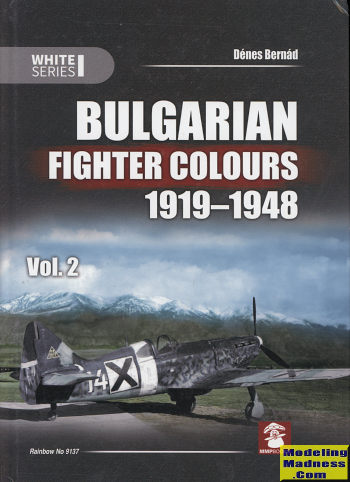MMP Books' Bulgarian Fighter Colors 1919-1948 vol 2
|
Author: |
Denes Bernad |
|
Publisher |
Mushroom Models
Publications |
|
Price |
$65.00 from
www.casematepublishing.com
|
|
Reviewer: |
Scott Van Aken
|
|
Notes: |
#9137 ISBN 978-8-36-595819-8
300 pages, hardbound, color profiles and photos, 8.25x11.5 inches |
 MMP Books
seems to be on a campaign to provide camo and markings enthusiasts with a nice
line of quality books on those air arms or subjects that have not been all that
well covered. Bulgaria is definitely one of those whose aircraft camouflage
schemes have been only sparsely covered.
MMP Books
seems to be on a campaign to provide camo and markings enthusiasts with a nice
line of quality books on those air arms or subjects that have not been all that
well covered. Bulgaria is definitely one of those whose aircraft camouflage
schemes have been only sparsely covered.
Bulgaria was partnered with Austria-Hungary
and Germany in WWI and so was under the same draconian international rules right
after the war. This meant no air force, though there was limited civilian
flying. It wasn't until a few years after Germany started its military build up
that Bulgaria began looking to rebuild its air force. One of the places that it
was able to get arms at all was from Germany so it is quite understandable that
most of the aircraft that eventually got into service were from that source.
These aircraft were mostly new build
planes, though they were also able to obtain a number of ex-Czech types when the
need to fill squadrons became critical. Most aircraft remained in the camouflage
scheme with which they were delivered, though some were repainted or overpainted
with local colors.
This second volume covers three aircraft,
but for the most part they were planes that were widely used and so the coverage
on these types is extensive.
The first type covered is the Bf-109G.
Bulgaria received a considerably number of these planes of different variants,
though the G-2 was the version that was initially supplied, and in fairly large
numbers. The 109G was the most potent fighter to enter Bulgarian service during
the war and its operations and colors consume the majority of the book. It is
with this aircraft that most Bulgarian aces were able to achieve their best
scores.
The second is the Avia B-135. Only a
small number were ever bought and the time from the signing of the contract
until the aircraft were eventually delivered was years, which in a war means
that the planes were fairly obsolescent by the time they arrived. They served
with advanced fighter schools and were not well liked at all by those who flew
them.
The third type is the
Dewoitine D.520. This aircraft was ordered as there was a need for more fighters
once the USAAF started bombing raids in Bulgaria. Most of the planes were new
build as the factory in southern France had been taken over by the Germans and
new planes were being produced for Luftwaffe use. They arrived in the scheme you
see on the book cover though without the white band and Bulgarian insignia.
Initially they flew in Luftwaffe markings. Although quite capable fighters in
1940, by 1943/44 they were showing their age. Despite this, Bulgarian pilots had
quite a bit of success with these planes against US bomber streams.
Typical of this series there are superb and
quite large photographs of not only planes but some of the luminaries. Though
not all planes saw combat, when they did, those combats are included in the
book, so you get a war history in addition to a look at the planes and their
markings. There is an incredible amount of information included in here and that
is what makes it such a great book. This is not one of your weekend read, but an
interesting and informative reference that all who are interested in the subject
need to have in their collection.
April 2020
Copyright ModelingMadness.com. All rights
reserved.
Review book courtesy of
www.casematepublishing.com. You can
get yours
at this link.
If you would like your product reviewed fairly and fairly quickly, please
contact
the editor or see other details in the Note to
Contributors.
 MMP Books
seems to be on a campaign to provide camo and markings enthusiasts with a nice
line of quality books on those air arms or subjects that have not been all that
well covered. Bulgaria is definitely one of those whose aircraft camouflage
schemes have been only sparsely covered.
MMP Books
seems to be on a campaign to provide camo and markings enthusiasts with a nice
line of quality books on those air arms or subjects that have not been all that
well covered. Bulgaria is definitely one of those whose aircraft camouflage
schemes have been only sparsely covered.